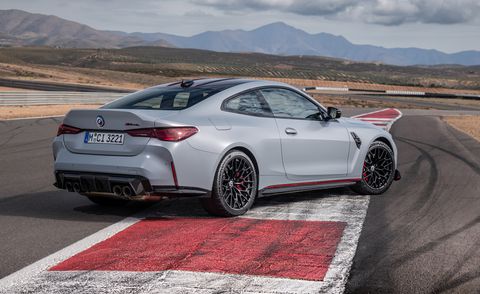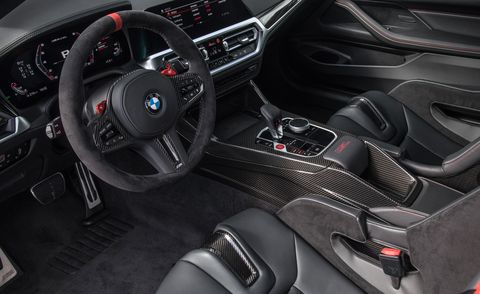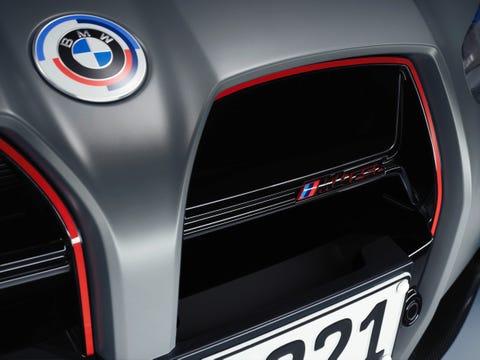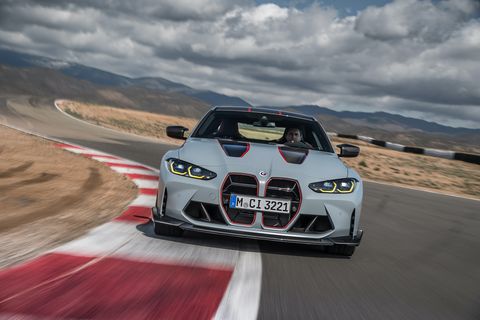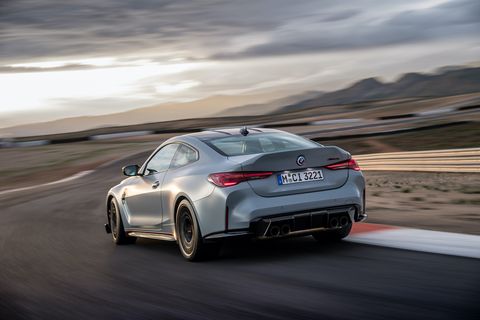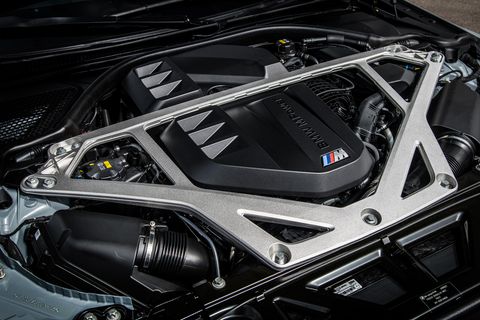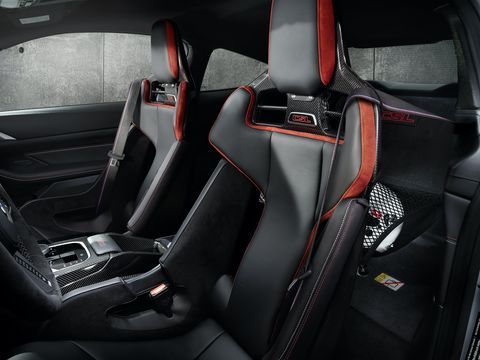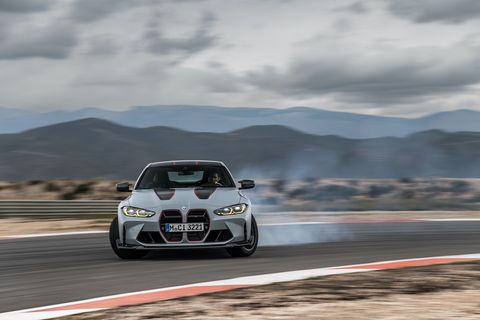2023 BMW M4 CSL, All you want to know & watch about a Great Car
2023 BMW M4 CSL Is 240 Pounds Lighter and Packs 543 Horsepower
The Competition Sports Lightweight model features numerous modifications over the standard M4 Competition and starts at a steep $140,895.

- The M4 CSL’s twin-turbo 3.0-liter inline-six makes 543 horsepower, some 40 hp more than the M4 Competition, and the car is also lighter than its counterpart by 240 pounds.
- The handling is more track-day focused thanks to a lower stance, standard high-performance tires and carbon brakes, and more aggressive suspension tuning.
- This special-edition M4 CSL will be limited to 1000 units worldwide and costs $140,895.
BMW’s new 2023 M4 CSL is a focused track-day special edition that is optimized for those who are willing to give up a chunk of daily-driver livability for substantially enhanced performance. CSL stands for Competition Sports Lightweight, and the specs show this to be more than a mere marketing term. They also show that this car will almost certainly be a brute that won’t appeal to everyone.
It’s powered by the same twin-turbo 3.0-liter inline-six that powers the M4 Competition, but the CSL’s peak turbo boost has been raised from 24.7 psi to 30.5 psi, a 24 percent increase. The dual-circuit cooling system has been upgraded to suit not merely the extra power, but also the rigors of track use. The result is 543 horsepower, some 40 hp more than the Competition, with the same power peak of 6250 rpm. Maximum torque is also unchanged at 479 pound-feet, which means the eight-speed automatic transmission and driveline from the Competition can be used as before, right down to the automatic’s internal ratios and the final-drive ratio inside the M Sport differential.
The shift points have been performance-optimized, however, and the engine and transmission mounts have been substantially stiffened. There should be far less slack and windup in the power delivery, but an increase in cabin vibration is almost certain to be a side effect.
The effects of this extra power are magnified by a massive 240 pound weight reduction. Each of the M4 Competition’s horsepower has 7.7 pounds to move around, but the extra power and lighter weight of the CSL drops that significantly to 6.7 pounds per pony. BMW claims that it will get to 60 mph in 3.6 seconds, compared with the Competition’s claimed 3.8 seconds, but we think it’ll do better.
The CSL is a two-seater that sheds its rear seat and seatbelts to save 46 pounds right off the top. Beyond that, its one-piece carbon front buckets save 53 pounds, but you can choose to add 32 pounds back if you order adjustable carbon seats. Another 33 pounds in savings comes from the use of lightweight sound insulation—and quite possibly less of it—in certain areas. More carbon-fiber reinforced plastic (CFRP) is used inside and out, including for the center console that saves 9 pounds.
At the tail end of the exhaust, another 9 pound savings comes from the use of a titanium silencer that’s tuned so it “can be fully appreciated inside the cabin where it provides the driver with accurate acoustic feedback in response to movements of the accelerator and clearly conveys the engine’s performance characteristics.” Which is a roundabout way of saying it’s louder.
The CSL comes standard with the 275/35ZR-19 front and 285/30ZR-20 rear high-performance tire combination that’s optional on the Competition, but the wheels are mounted on CSL-exclusive forged alloys with slender spokes that shave off more weight. Carbon-ceramic brakes that are optional on other M4s are standard here, and the wheels, brakes, and certain lightweight suspension components add up to another 46 pounds saved, with much of this being unsprung weight.
The suspension squats some 0.3 inch lower than the Competition, and it has been recalibrated with CSL-optimized springs, adaptive damper valving and software, and altered stabilizer-bar tuning. Also notable is the use of additional monoball joints in certain rear suspension links instead of rubber bushings in the interest of more precision when on the track. This last tidbit reminds us of similar suspension changes made to the Porsche Cayman GT4 RS, which delivered stellar handling as a result, as well as questionable livability.
All signs point to a much more capable and raw BMW M4 that will indeed be a more potent track-day weapon. There’s a single-minded approach at work here, and it should absolutely appeal to those who want to put their M4 on the track. How many BMW fans are looking for what the M4 CSL has to offer? We’ll see once we know how long it takes the 1000 units—each priced at $140,895—to sell out.
BY
2023 BMW M4 CSL: A 543-HP Lightweight Tribute to M’s Glory Days
The CSL name only goes on the most iconic BMWs. The new M4 CSL has a lot to live up to.

The new M4 CSL is a 543-horsepower track junkie weighing in at 3,640 pounds, after losing a rather heavy passenger’s worth of weight through clever engineering and material upgrades. For those of you who care deeply about Nürburgring times, the new BMW M4 CSL’s 7:20.2 result puts it right between a Ferrari 488 GTB and a 991 Porsche 911 GT3 RS. That’s not too shabby for a front-engine coupé costing considerably less. Yet it is far more interesting how BMW managed to create its most hardcore M3/M4 special edition to date.
In the spirit of the “Competition, Sport, Lightweight” moniker, an evolution of the original 1973 BMW 3.0 CSL’s “Coupé, Sport, Lightweight” badging, the M4 CSL’s weight-to-power ratio of 6.7 pounds for every horsepower equals a 0 to 60 mph jump in 3.6 seconds, while top speed is limited to 191 mph.
Weight
Finding 240 unnecessary pounds in an already performance-oriented road car is tough. However, by making the CSL a two-seater equipped with M Carbon full bucket seats only, BMW managed to immediately cut 99 pounds. Then came the chassis alterations, including the standard M carbon-ceramic brakes (15.7-inch front and 15-inch rear), forged alloy wheels (19-inch at the front and 20-inch at the rear, finished in matte black), and lighter springs and struts teaming up for another 46 pounds off.
A minimalistic approach to sound isolation meant 33 pounds, while additional CFRP components inside and out saved 24 pounds in total. The modified BMW kidney grille, along with the different rear lights, lack of floor mats and automatic climate control lost eight pounds, and the titanium rear silencer is nine pounds lighter than the M4’s standard exhaust system.
Design
While the M4 Competition comes with a CFRP roof panel, the M4 CSL goes further with a “double bubble” CFRP roof, a carbon fiber hood (three pounds lighter than an aluminum one), as well as a CFRP trunk lid that saves a more substantial 15 pounds over the M4 Competition’s aluminum piece. The trunk lid features a ducktail spoiler, and there’s a diffuser integrated into the rear apron also made of CFRP, not unlike the CSL’s mirror caps. To show off this composite extravaganza, the CSL’s hood features two unpainted channels extending in line with the modified grille. These are even bordered in red, just to make sure you spot all the aero.
Running over the contours of its extended side sills and splitter, the red accents are designed to go perfectly with BMW’s new optional Frozen Brooklyn Grey metallic paint. However, you can also choose your M4 CSL in standard Alpine White or Black Sapphire metallic, leading to color options that include grey, white, or black. The BMW M 50 Years emblems are standard for the hood, trunk lid and wheel center caps. These recall the blue/violet/red logo first seen on BMW’s touring cars in 1973, and countless base BMWs ever since. BMW even changed its model badges for the CSL, this time using black surfaces with a red outline.
Lights
BMW Laserlight headlights are standard, and the angular daytime running lights illuminate in yellow rather than white. Meanwhile, the rear lights feature technology making its debut in a series-produced car. I’ll let BMW explain that one:
While all the light functions use LEDs, the glass covers have intricate light threads woven into them which are illuminated using laser technology, bringing a vibrant structure to the surface of the rear lights and creating a distinctive light signature recognizable from a long distance after dark.
The arrangement of the three threads, which run parallel to one another across the inner section of the light units and overlap each other in the outer area, creates a visually stunning interpretation of the hallmark BMW L-shaped rear light contour. Additionally, the illuminated “BMW Laser” lettering on the light covers hints at the innovative light technology below the surface.
Track Performance
The M4 CSL uses stiffer engine and transmission mounts, as well as a double-joint spring strut front axle and five-link rear axle. It comes with adaptive M Suspension with electronically controlled dampers, variable ratio electromechanical M Servotronic steering and an M-specific version of the integrated braking system, which offers two-way adjustable pedal feel.
Model-specific camber settings thanks to the front axle’s forged swivel bearing, new dampers, auxiliary springs and anti-roll bars improve cornering, while ride height compared to the M4 Competition was dropped by 0.3-inches. On the rear axle, four additional ball joints with zero play replace the rubber mounts for the control arms on both the axle subframe and wheel carrier sides, thereby lowering the secondary spring rates. The rear-axle subframe has a rigid connection to the body without any flexible rubber elements. That, you shall feel over a bump.
The M4 CSL is running on Michelin Pilot Sport Cup 2 R tires measuring 275/35 ZR19 at the front and 285/30 ZR at the rear, and its traction control system has five new settings for track usage. While stages 1 to 5 are the same as in the M4 Competition, 6 to 10 are mostly for circuit use. BMW says that the intervention thresholds are set extremely high in stages 6 and 7, which are designed for driving on a dry track with the tires at optimum temperature. If the tires are cold or too hot, however, or the track is damp or wet, drivers can engage stages 8 to 10, which gradually lower the intervention thresholds.
Engine and Transmission
It has 543 horsepower at 6,250 rpm, and peak torque of 479 lb-ft from 2,750 rpm to 5,950 rpm. To get an extra 40 horses out of the 3.0 twin-turbo six-cylinder, BMW modified the management software to raise boost pressure from 24.7 psi in the M4 Competition to 30.5 psi in the CSL. The engine mounts’ spring rates – which are set at 580 N/mm on the left side and 900 N/mm on the right in the BMW M4 Competition – were both increased to 1,000 N/mm.
Meanwhile, the transmission mounts are 12 percent stiffer. With the upgraded M Steptronic transmission, the CSL will accelerate to 120 mph in 10.5 seconds, and if you blip the throttle, the eight-speed ZF unit will even reduce undesirable engine braking when the car is being pushed hard.
Most crucially, the CSL’s lightweight titanium silencer is equipped with two electrically controlled flaps to give this special edition a distinctive engine note at a push of a button.
Inside
For your $141,000, the M4 CSL features a CFRP central console, as well as such comfort features as a leather-padded armrest and a wireless charging tray. The Alcantara steering wheel comes with a red center marker in the 12 o’clock position, carbon-fiber inlays on the three spokes and CFRP shift paddles. In front of those, the pair of bucket seats at your service are equally Leicht.
Created for this model, the M Carbon full buckets offer extremely high lateral support, and not much else. The backrest angle is fixed, and the seat height can only be adjusted in a workshop using a three-stage screw linkage. Fore and aft adjustments are made manually using a lever on the front edge of the seat. The head restraints can be disassembled for track use when the driver and passenger are wearing helmets. The seating surfaces and backrests are trimmed in black Merino leather, while the head restraints have red Alcantara inserts. Contrast stitching in M colors on the seat bolsters and the seat belts is a given.
If you don’t like the sound of that, heated M Carbon bucket seats with full power adjustment are available as a no-cost option. However, these seats are only 21 pounds lighter than the standard seats in the BMW M4 Competition, probably making it slower than a Ferrari 488 GTB around the Nordschleife. The stowage area behind the seats provides space for two helmets, as it should.
Happy birthday BMW M GmbH, it’s been one hell of a half century already, and the M4 CSL seems proper.
